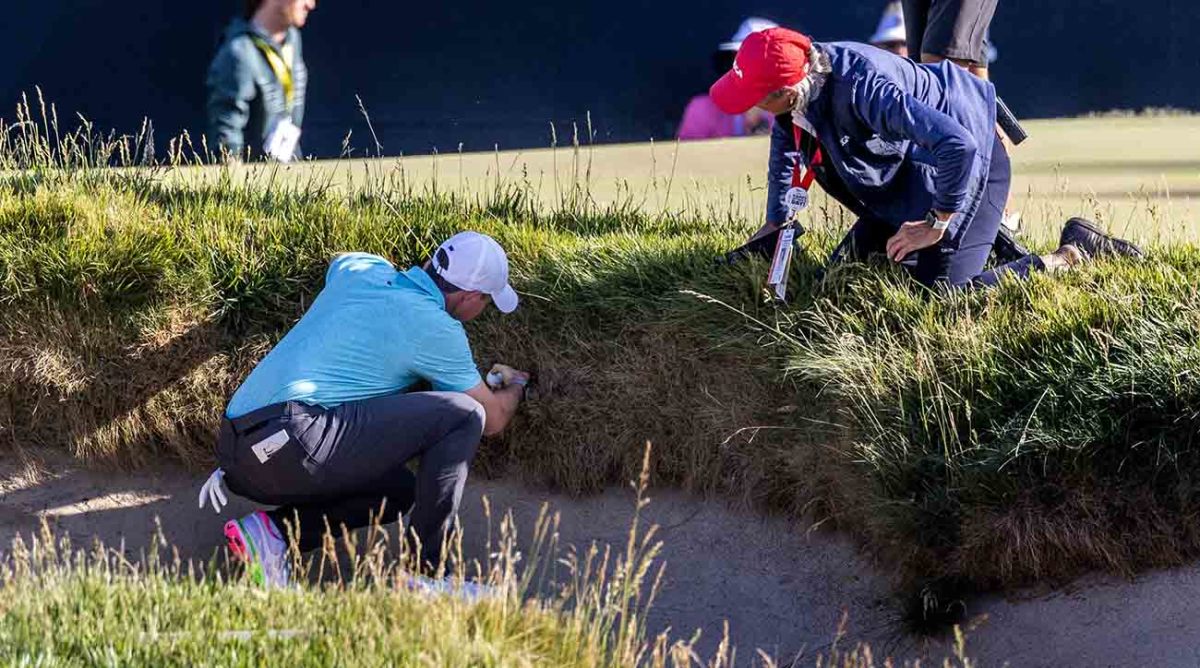USGA Admits to Incorrect Relief Measurement With Rory McIlroy in Final Round of U.S. Open

It ultimately didn’t factor in the outcome, nor did Rory McIlroy take much advantage of the situation.
But the ruling he got on the 14th hole during the final round of the U.S. Open at Los Angeles Country Club has still simmered some 10 days later, due in part to the oddity of the situation and his prominence in the game.
And a United States Golf Association executive told Sports Illustrated during an interview Monday that while McIlroy did nothing wrong, the spot from which he measured his point of relief from an embedded lie above a bunker was incorrect.
“The nearest point of relief was mis-identified; it should have been directly behind the ball," said Thomas Pagel, the USGA’s chief governance officer. "If there’s no area immediately behind the ball, you go to nearest point in the general area. But if you look at where the ball was embedded, there was a grassy area below and that should have been the starting point."

During the final round of the U.S. Open, McIlroy was in contention when he played the par-5 14th hole. For his third shot from 125 yards, McIlroy’s wedge came up short and flew directly into the hill above the bunker and below the green.
A search ensued for the ball that was ensnarled in the grass and found by playing partner Scottie Scheffler. The rules official on site determined that the ball was embedded—it had broken the surface, according to Pagel.
After a free drop, McIlroy was unable to get his ball up and down from off the green, making a bogey 6. He finished one stroke behind winner Wyndham Clark.
"His ball was 100 percent embedded," Pagel said. "And an embedded ball not in sand is entitled to relief. Now Rory did everything at the discretion of the referee. In her discretion, her judgment was that the reference point for relief was to the side of the ball. And from a ruling standpoint, that’s the end of the story."
The rules official was Courtney Myhrum, a member of the USGA’s executive committee who has played in 15 USGA championships and officiated more than 60 USGA championships, including U.S. Opens, U.S. Women’s Opens, U.S. Senior Opens and U.S. Amateurs. She also served on the USGA’s Women’s committee from 2011-19.
Pagel said “she’s an extremely well-qualified referee and she did everything in her judgment where to operate the drop. However, after further review it was determined that there was a spot in the general area immediately behind the ball that was the reference point for relief."
Rule 16.3 deals with relief from an embedded lie through the green. Had the ball not been embedded, McIlroy would have had to play it as it were or taken an unplayable lie penalty.
As it was, he was entitled to a drop one club length no closer to the hole from the spot to be deemed "the general area" of the embedded spot. Dropping in the bunker was not an option.
McIlroy can be seen in photos marking that spot with a tee with Myrhum instructing him.
"If you look at where the ball embedded, just below should have been the starting point (for taking one club length relief)," Pagel said. “But even if his club length had been measured from behind the ball, he still would have been dropping on the shelf from where he played from. As it was, he measured the club length from the top of the wall to the right. As he dropped the ball out of that area, he had to drop a second time."
Pagel estimated the difference between where McIlroy dropped and where he should have dropped was no more than 18 inches and that he still would have been atop a shelf from where he had a tough pitch over to a sloping green.
"When you start dealing with vertical faces, that’s where the question is," Pagel said. "In this case, there was a lot going on. But there was a place behind the ball where he could have started to measure."
To make sure the ball would be no closer to the hole, McIlroy started measuring from a point to the right of the flagstick on an angle up the hill but away from the hole, Pagel said.
"From where he started measuring from, he didn’t get a break. And he did all of this at the discretion of the referee," Pagel said. “He wasn’t doing anything to gain an advantage and as he was told how to apply the rule on where to drop."
